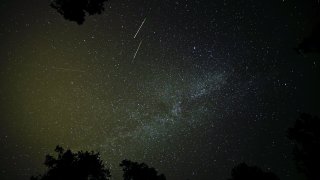
The Chicago area will likely be in for a show in the sky over the next week.
From meteor showers sailing through the air to Venus moving up 30 degrees into the sky, Chicagoans could spot an array of space phenomenons in upcoming days leading up to the rare lunar eclipse arriving about halfway through the month.
According to EarthSky, the meteoroid streams through the South Taurid peaked from Thursday into Friday, bringing fireball-like meteor sightings for those who caught a glimpse.
If you missed the shower, however, you may still be in luck.
The South and North Taurid meteors are expected to rain down over the next week, according to EarthSky.
Next week, the North Taurid meteor shower will peak from later at night on Nov. 11 until dawn on Nov. 12, EarthSky reported. Typically, the shower will peak at around midnight.
Throughout the month of November, Venus will also shine brightly after sunset, according to the Adler Planetarium.
Local
On Sunday evening, Venus can be seen just tot he left of a "very slim waxing crescent moon," the planetarium noted. The planet sets just after 7 p.m.
According to the planetarium, the Chicago area will be able to watch the full moon fade away and reappear within a matter of hours on Nov. 19.
Feeling out of the loop? We'll catch you up on the Chicago news you need to know. Sign up for the weekly Chicago Catch-Up newsletter.
In the morning, the full moon passes through Earth's shadow, the planetarium noted, becoming almost entirely eclipsed as viewed from the area.
"You may notice the very bright Moon starts to dim slightly several minutes after midnight Central Standard time," the planetarium said.
The eclipse's partial phase begins at 1:18 a.m., ending at 4:47 a.m., according to experts. The maximum eclipse is expected to occur at 3:02 a.m.
"At maximum eclipse, almost all of the Moon is within the boundaries of the Earth’s darker umbral shadow, leaving only a thin sliver still in the Earth’s lighter penumbral shadow," the planetarium added.
Though experts are not certain what color this eclipse will take on, historically the sighting can take on a gray, orange or reddish tone.
During the month of November, there was a new moon on Nov. 4, with the first quarter moon arriving on Nov. 11, a full moon coming in on Nov. 19 and the last quarter moon visible on Nov. 27.



